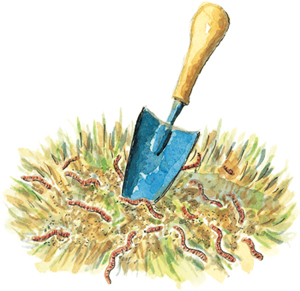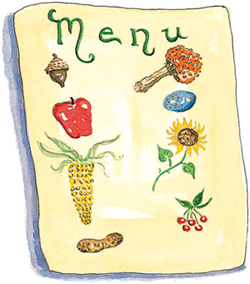
We all know about the bad bugs in the garden, but there are also good bugs and other helpful critters that you’ll want to lure into your yard. An unseen (or overlooked) workforce is out there just waiting to get an invitation to help in the garden. If you’re like me, you can use all the allies you can get to defeat the critters destroying your plants. First, you’ll need to keep your environment poison-free. Then, to keep everybody happy, it takes food (a diverse array of plants), water, and an assortment of simple and seductive lures.

Birds can rid your garden of many unwanted pests. To attract numerous species of birds and promote a healthy, well-balanced garden, choose the seed-producing plants birds love:
black-eyed Susans
coneflowers
coreopsis
cosmos
feverfew
millet
scabiosa
sunflower
Allow a dead tree stump to remain standing if it’s not a threat to you or your home. Dead trees house, feed, and encourage insect-eating birds such as chickadees, wrens, flickers, nuthatches, and woodpeckers to stay in your garden. They also provide homes for rodent-eating predators such as owls, hawks, and kites.
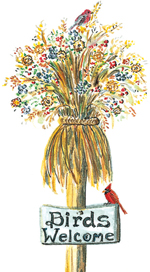
In orchards and vineyards, lure rodent-eating hawks and owls onto the grounds by placing “T” posts at least 10 feet tall, every 100 feet.
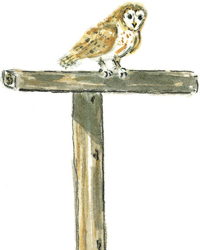
Encourage insect-eating birds to set up house by furnishing them with nesting materials.
Stuff a mesh bag with narrow grasses, fine strips of bark, thistle, milkweed, feathers (many birds prefer white feathers), or cattail down. Hang the bag in a sheltered area protected from rain and cats.
Feed the birds and foil your foes by placing a board in a shaded, moist area of your garden. Slugs and bugs seek shelter beneath such a hideout. Turn the board over each morning and allow the birds to pick it clean for you.
Set up a platform feeding station (or sunflower seed feeder) to attract chickadees, nuthatches, finches, or other birds that will pluck hundreds of loopers and cabbage worms from your garden daily.
Water attracts birds through every season, even in the worst winter storms. Put out birdbaths, shallow saucers of water, or a fountain with a trickle of water.
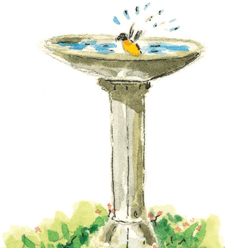
Berry-bearing shrubs and fruit trees attract thrushes and other insect-eating birds. Here are some to choose from:
barberry
blueberries
coffeeberry
cotoneaster
crabapples
cranberries
currants
dogwood
elderberry
grapes
holly
mahonia
pyracantha
roses
serviceberry
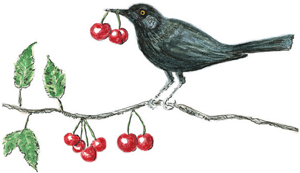
While bats aren’t the prettiest critters, they’re some of the best pollinators, seed dispersers, and pest fighters in the world. On warm nights many bats eat nearly their body weight in insects, so it’s worthwhile to attract them.
Illuminate a portion of your yard with a mercury-vapor lamp or incandescent lights. Moths and other garden pests flock to the light; bats will quickly follow, and feed.
Install a set of old shutters to attract and house bachelor bats. Mount the shutters at least 15 feet high, on the sunny side of a barn, garage, or outbuilding. Bats like to slip through the narrow slats and hang from them.
Place bat houses (see Appendix) on 10- to 15-foot-tall posts throughout your garden.
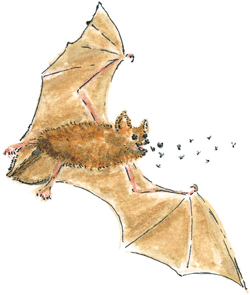
Little Brown Bat eats on the wing.
Aphid lions (the name says it all), the offspring of green lacewings, are one of your best allies against all sorts of pests. Recent studies in Switzerland have shown that more eggs and young of the lacewings are found among borage than anywhere else in the garden. If you interplant borage among your vegetable and flower crops, you will eliminate many pest problems.
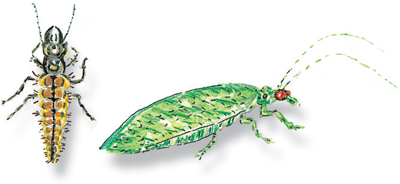
Left: Aphid lion
Right: Lacewing
Box turtles feast on slugs, snails, insects, and grubs. They’re slow but thorough garden patrollers and great helpers.

Provide a trough, half-barrel, or small pond to welcome frogs. They consume slugs, grubs, insects and larvae, and other invertebrates. Refrain from applying herbicides, pesticides, and chemical fertilizers near water.
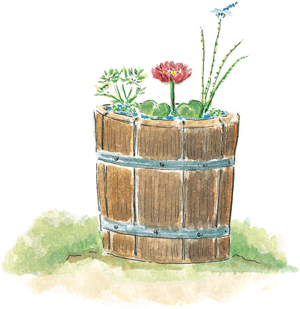
Invite insect-eating toads, box turtles, salamanders, and lizards into your garden by placing small piles of wood or rocks in secluded areas of your yard. (See Appendix, for how to construct a permanent wood pile.)
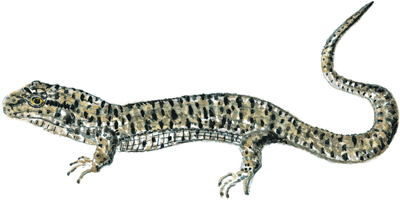
Alligator Lizard
Set a pot half buried on its side in a shady area among plants troubled by loopers, earwigs, and slugs. Or, chip a toad-sized hole along the rim for a door, and set a pot upside down in your garden. Apply a thick layer of mulch to the surrounding ground for a hideout and supply of insects.
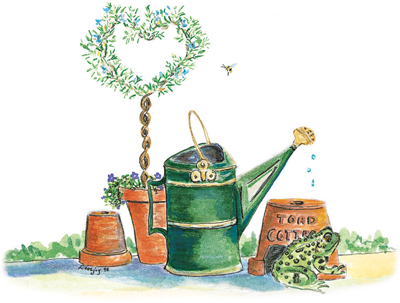
Small piles of leaves or needles throughout your garden attract predatory ground beetles. They feed on insects, grubs, slugs, and snails.
Jerusalem crickets feast only on dead and decaying vegetation. They’re seldom seen because they do most of their good work at night.
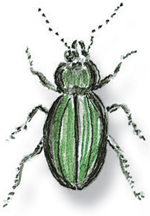
Beneficial ground beetle
Firefly larvae, the luminous glowworms found in gardens, are voracious eaters, with an appetite for larvae, mites, slugs, snails, and cutworms. Entice them into your garden by leaving some ground unmowed, or plant some native grasses and wildflowers, and refrain from spraying pesticides. The glowworms will thank you by gobbling up your problems.
Dragonflies can consume 300 insects a day. Lure them to your yard with an old tub, trough, or small pool filled with water. Stick tall bamboo stakes into submerged, soil-filled pots, making sure the twigs protrude above the water. Dragonflies like to perch on these stakes.
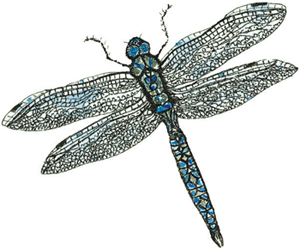
Multicolored darner
Ladybird beetles and their young larvae, aphid wolves, feed on aphids, scale, whitefly, mealy bugs, and mites. Attract them by mixing 5 ounces sugar in 1 quart water. Shake well and pour into a spray bottle. Spray onto aphid or scale-infested plants, but don’t spray directly onto the beetles; it will cement their wings together.
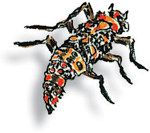
Aphid wolf
On cold, early-spring days, when many plants and fruit trees are in bloom and imported honeybees are still snoozing, our native pollinators the bumblebees, orchard mason bees, and flower flies are out and about, ensuring bountiful crops for our gardens and orchards.
Salt, minerals, nectar, and moisture are necessities for butterflies, skippers, and bees. In a sunny area out of the wind, set out shallow saucers containing moist soil and a sprinkling of salt.
Place a flat rock in the soil, drop a dab of jelly or a moist cube of sugar on top, and watch the butterflies zoom in to sip the sweet juice.
Or take the one-step approach: set saucers with rotting fruit throughout your yard.
Lure native bees to your garden with a grouping of wooden bee homes (see Appendix).
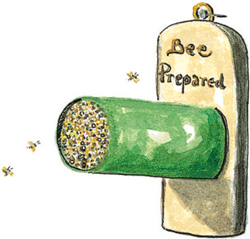
Stuff old coffee cans with lengths of slender bamboo shoots, sunflower stalks, and elderberry canes, and mount the cans in a sheltered location, for example, under a roof.
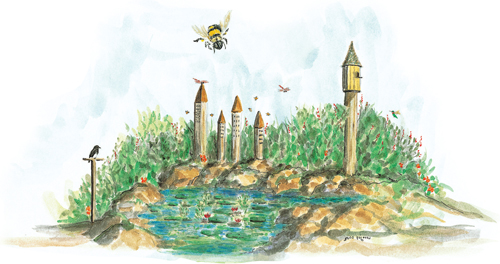
Mason bee apartments.
Beneficial insects and butterflies need small, accessible supplies of sipping water. Grow cup plant (Silphium perfoliatum), which has a tiny, water-catching basin at the base of each leaf.
Bumblebees, some of the most energetic pollinators, will seek out homes in man-made boxes or terra-cotta pots (see Appendix). Drill ⅝-inch holes to allow bumbles in and to keep mice out.
Butterflies will seek shelter inside a leaf-filled can. Nestle coffee cans filled with leaves and pine needles in the crotches of trees, or nail them to fences and walls protected from the prevailing winds.
A hedge of bountiful, blooming four o’clocks will attract sphinx moths to your yard. These lightning-swift insects can pollinate more than two hundred flowers in less than seven minutes.
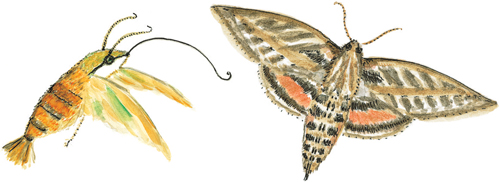
Sphinx moth
Snakes help control small rodents and many insect pests, and 99 percent of snakes found in yards are harmless. (There are only a few poisonous species in the entire United States; consult a good reptile book to learn if there are any in your area.)
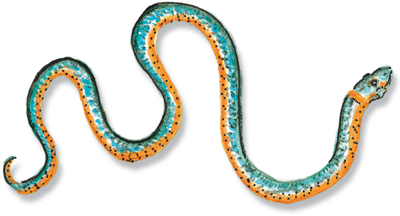
 If you have a rock wall, insert a plastic drain pipe horizontally into the rocks at ground level and leave the pipe slightly exposed to provide access for reptiles.
If you have a rock wall, insert a plastic drain pipe horizontally into the rocks at ground level and leave the pipe slightly exposed to provide access for reptiles.
 Make a space for snakes. Mound some twigs and branches, cover them with a black tarp, and weight the edges with rocks. (You can disguise the mound with a layer of mulch.)
Make a space for snakes. Mound some twigs and branches, cover them with a black tarp, and weight the edges with rocks. (You can disguise the mound with a layer of mulch.)

Reading back through a journal is like visiting old friends.
Attract predatory mites with potently scented wintergreen. Soak some cotton balls in pure oil of wintergreen. Stuff the balls into empty ½-ounce vials, wrap the necks of the vials in nooses of wire, and hang them wherever mites are a problem. Predatory mites will be attracted and stay to consume pests and their eggs.
 To fight bad mites, mix a solution of 1 tablespoon pure oil of wintergreen (found in health-food stores) and 1 tablespoon liquid soap in 1 gallon water and spray infested plants.
To fight bad mites, mix a solution of 1 tablespoon pure oil of wintergreen (found in health-food stores) and 1 tablespoon liquid soap in 1 gallon water and spray infested plants.
Gardeners are just now realizing what Chinese farmers have known for millennia—that a garden or field filled with a diverse population of spiders promises rich productivity. Spiders are responsible for about 80 percent of the biological control in a healthy garden.
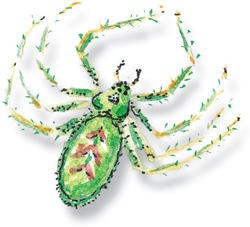
Green lynx spider
 Turn terra-cotta pots upside down (holes up) in your garden. Spiders enter the holes and take up residence. They’ll tackle earwigs, sowbugs, and beetles, and feast on larvae emerging from the soil and heading toward the light.
Turn terra-cotta pots upside down (holes up) in your garden. Spiders enter the holes and take up residence. They’ll tackle earwigs, sowbugs, and beetles, and feast on larvae emerging from the soil and heading toward the light.
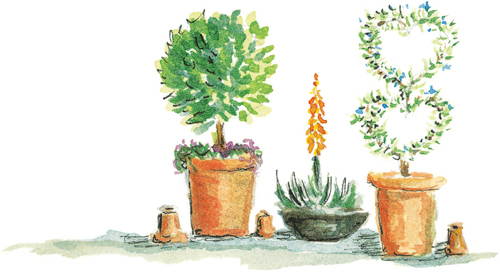
Three small spider apartments.
“Did you ever think how a bit of land shows the character of the owner?”
—Laura Ingalls Wilder
 Furnish spiders with a recycled home made from an old produce crate, and turn it upside down in borders, beds, and fields. Soybean growers who have experimented with crates in the midst of their fields found that pest damage to plants was less in the immediate area surrounding the spider boxes.
Furnish spiders with a recycled home made from an old produce crate, and turn it upside down in borders, beds, and fields. Soybean growers who have experimented with crates in the midst of their fields found that pest damage to plants was less in the immediate area surrounding the spider boxes.
 Build small twig mounds throughout your garden to shelter spiders, or stack a permanent rock-pile home for them.
Build small twig mounds throughout your garden to shelter spiders, or stack a permanent rock-pile home for them.
 Mulch your beds with grass clippings and compost; this supplies spiders with a dark, moist, sheltered environment from which to launch bug patrols.
Mulch your beds with grass clippings and compost; this supplies spiders with a dark, moist, sheltered environment from which to launch bug patrols.
 Always avoid using broad-spectrum pesticides, which destroy spiders and a host of other beneficial insects.
Always avoid using broad-spectrum pesticides, which destroy spiders and a host of other beneficial insects.
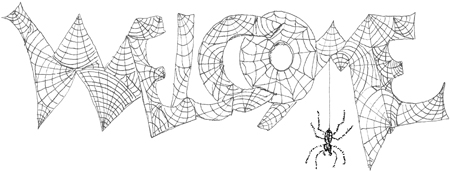
“It is by studying little things that we attain the great art of having as little misery and as much happiness as possible.”
—Samuel Johnson
Worms work magic as they eat their way through the earth, leaving behind a vast network of slime-sided tunnels and rich mounds of nutritious castings (worm manure). Their excavations improve soil structure, increase aeration and root penetration, and allow water to percolate slowly and deeply into the ground. Before you mulch your beds to encourage a worm population, the most important thing is to stop using harsh fertilizers and pesticides.
